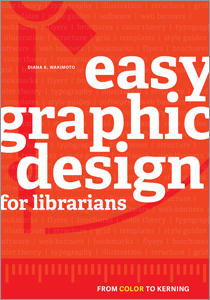Primary tabs
You don't need to be an ALA Member to purchase from the ALA Store, but you'll be asked to create an online account/profile during checkout to proceed. This Web Account is for both Members and non-Members. Note that your ALA Member discount will be applied at the final step of the checkout process.
If you are Tax-Exempt, please verify that your account is currently set up as exempt before placing your order, as our new fulfillment center will need current documentation. Learn how to verify here.
- Description
- Table of Contents
- About the author
- Reviews
From the layout of a library’s web banner to its printed newsletter to the swag handed out during summer reading programs, libraries make their visual identities known through the many forms of communication they produce and share. And even if “graphic designer” isn’t technically in your job description, chances are you’re still doing it. Wouldn’t you like to do it better? In this approachable introduction to graphic design, Wakimoto speaks directly to library staff. Her book leads readers through a structured exploration of design concepts that can be applied immediately to library-specific projects. Perfect for complete novices as well as those wishing to build on existing skills, this book
- offers a concise overview of graphic design fundamentals such as typography, color, layout, and using images;
- outlines a design process for busy librarians that emphasizes a pragmatic approach to creating materials;
- explains how to use tools like templates and style guides, and how to choose the right software for a particular project;
- includes guidance on creating bookmarks, brochures, flyers, and buttons;
- shows how to get more bang for your buck through flexible designs that can be repurposed;
- delves into web banner design; and
- provides a resource guide and suggestions for further readings.
Under Wakimoto’s tutelage, librarians in any setting can apply what they learn to create engaging, effective visual communications for their libraries.
Acknowledgments
Introduction: Librarians as Graphic Designers
Part I: Graphic Design Fundamentals
1. Design Process for Librarian Graphic Designers
2. Structure Your Library’s Designs
3. Typography for Librarians
4. Colorize Your Library’s Communications
5. Images to Enhance Your Library’s Message
6. Design Software for Any Library Design Project
7. Templates and Style Guides: Share Your Graphic Design Knowledge
Part II: Projects
8. Bookmark Redesign
9. Brochure Redesign
10. Design Themes: Two-for-One Design
11. Web Banner Design
12. Flyer Design
13. Button Designs
Conclusion: You Are a Librarian Graphic Designer
Appendix: Resources
Bibliography and Further Readings
Index
Diana K. Wakimoto
Diana K. Wakimoto is an associate librarian at California State University, East Bay. Her current research focuses on librarians’ preparation in graphic design and the use of graphic design best practices in libraries. She has published research studies and presented at local and national conferences on these topics. She is the author of the The Waki Librarian blog, where she writes about graphic design and libraries.
"Librarians looking for a succinctly packaged overview of graphic design principles will not be disappointed; it will be especially useful to those tasked with developing a style guide or branding for their library or program."
— VOYA
"Wakimoto is a librarian and blogger who writes about graphic design, and her enthusiasm for both good design and communicating a library’s mission will inspire those who might otherwise have slapped a bunch of text onto a page in Word. Throughout, she emphasizes that the goal of good graphic design is not necessarily aesthetic beauty but clear and effective communication."
— Booklist
"The how-to manual librarians didn’t know they needed ... Any librarians tasked with even rudimentary graphic design responsibilities would benefit from absorbing and applying the lessons within this book."
— ARBA



